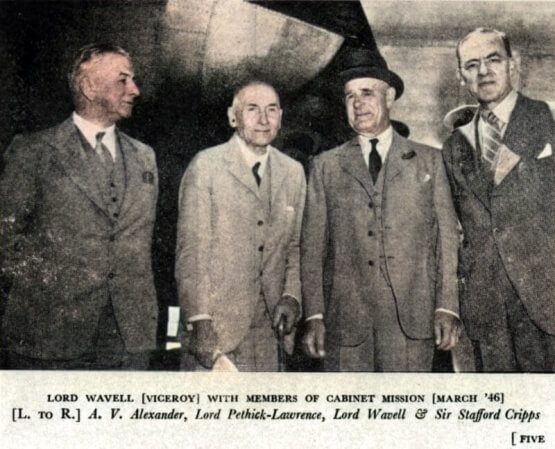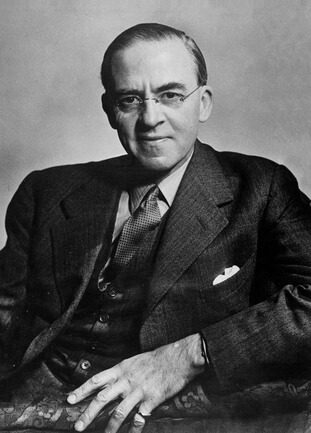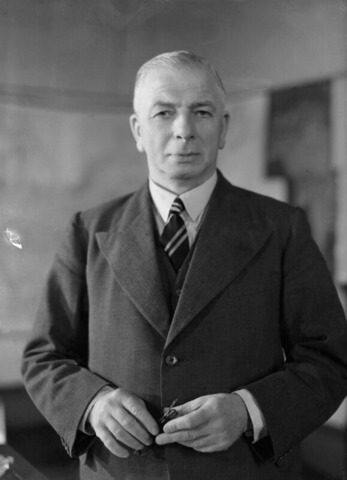Cabinet Mission, March-May 1946, Its Members, Plan

The announcement and coming of the Cabinet Mission to India was an important point during the Indian National Movement.
Table of Contents
Background and Reasons for Sending the Cabinet Mission
Toward the end of the Second World War, significant developments took place on the international front. At the same time, changes in the UK Government in July 1945 forced the British government to look into the longstanding demands of the Indian political leaders. On the same lines, on September 19, 1945, the Viceroy of India, Lord Wavell (October 1943 – February 1947) in a public broadcast announced the UK’s Labour government’s new India policy:
“…His Majesty’s Government are determined to do their utmost to promote in conjunction with the leaders of Indian opinion the early realisation of full self-government in India.”
He further said,
“…It is the intention of His Majesty’s Government to convene as soon as possible a constitution-making body…”
Thus, the longstanding demand of the Indian political leaders, first made in the mid-1930s, for a Constituent Assembly manned by Indians, was finally materialising. The general elections held in India for the central assembly and provincial assemblies held between December 1945 and January 1946 alongwith the mass upsurge due to the trial of the Indian National Army (INA) at Red Fort in Delhi in December 1945 and the mutiny by Royal Indian Navy (RIN) ratings in February 1946 further fuelled the demands of the Indian political leaders. (Ratings – in the navy during the British period, a rating was a junior enlisted sailor who was not a warrant officer or commissioned officer)
Subsequently, after five-months on February 19, 1946, the Secretary of State for India, Lord Pethick-Lawrence (August 1945 – April 1947) announced in the House of Lords in the UK Parliament, that,
“In view of the paramount importance not only to India and to the British Commonwealth but to the peace of the world of a successful outcome of the discussions with the leaders of Indian opinion His Majesty’s Government have decided, with the approval of His Majesty the King, to send out to India a special Mission of Cabinet Ministers consisting of the Secretary of State for India, the President of the Board of Trade, and the First Lord of the Admiralty, to act in association with the Viceroy in this matter. This decision has the full concurrence of Lord Wavell.”
Who were the members of the Cabinet Mission?
Subsequently, three Cabinet Ministers of the UK Government led by Prime Minister Clement Attlee (of the Labour Party) arrived in India on March 23, 1946, and remained in India until June 29, 1946. These three members were:
- (i) Lord Frederick Pethick-Lawrence, the Secretary of State for India
- (ii) Sir Stafford Cripps, President of the Board of Trade
- (iii) Albert Victor Alexander, First Lord of the Admiralty
Although Viceroy Lord Wavell participated in some of the meetings held by the Cabinet Mission while in India, officially he was not part of the Cabinet Mission.
Since all three members were Cabinet Ministers and were being sent to India for a specific mission, this came to be known as the Cabinet Mission .

Lord Frederick Pethick-Lawrence, the Secretary of State for India

Sir Stafford Cripps, President of the Board of Trade

Albert Victor Alexander, First Lord of the Admiralty
What was the mission of the Cabinet Mission?
As announced by the Secretary of State for India, Lord Pethick-Lawrence (August 1945 – April 1947) in the House of Lords in the UK Parliament, on February 19, 1946, the special Mission of Cabinet Ministers was:
“To assist in the setting up of a constitution-making body”
in India after discussion with various political leaders and stakeholders including Princely States.
What were the main objectives of the Cabinet Mission?
The main objective of the Cabinet Mission was to come up with agreed ways for the political and constitutional future of India. The main objectives of the Cabinet Mission were three-fold. These were:
- (i) To come up with an agreement with the Indian political parties and leaders on the framing of a constitution for India.
- (ii) To formulate a constitution-making body that would be responsible for framing a constitution for India.
- (iii) To establish an Executive Council with the help and support of the major political parties in the interim period.
Cabinet Mission in India, March 23 – June 29, 1946
The members of the Cabinet Mission arrived in Karachi on March 23, 1946. Over the following months, they met with leaders of various political parties and others at the Viceroy’s lodge in Shimla. Viceroy Lord Wavell also participated in some of the meetings of the Cabinet Mission held in India. The Cabinet Mission discussed with various political parties including Congress, Muslim League, Hindu Mahasabha, Liberals, and others. The discussions with the Congress party were led by its president Abul Kalam Azad in April-May 1946. In May 1946, Jawahar Lal Nehru took over as Congress president and carried forward the discussions with the Cabinet Mission. Muslim League was represented by Muhammad Ali Jinnah and Sikhs were represented by Master Tara Singh. The Cabinet Mission submitted its plan on May 16, 1946, which came to be known as the Cabinet Mission Plan. The Cabinet Mission left India on June 29, 1946.
Cabinet Mission Plan or Proposals
From March 23, 1946, until mid-May 1946, the Cabinet Mission had a series of discussions with leaders of various political parties and stakeholders. Based on these discussions, on May 16, 1946, the Mission proposed a plan that came to be known as the Cabinet Mission Plan.
The Cabinet Mission Plan: The Plan was around nine pages long, having around twenty-four points. The core of the Plan is Point 15 which lays down the basic form of the future constitution of India. Point 15 consisted of six sub-points that proposed the basic form of the Constitution of India. The point 15 is comprised of two parts, a short-term and a long-term plan.
The Plan rejected the demand of the Muslim League, for a separate state of Pakistan and instead called for an Indian Union that consisted of both British provinces and the Princely States. While the Plan rejected Pakistan, it proposed a unique federal set-up that it hoped would be best and acceptable to the Congress Party and the Muslim League, as, it introduced the concept of grouping/sections; provinces and princely states were free to form groups under the Union, having a legislature and executive, enjoying significant autonomy.
Long-term Plan: In the long-term plan, there were primarily six proposals. These were:
1. Union of India: The plan proposed the creation of a Union of India, which should be a federation of British India and the princely states. This Union would have a central government responsible for defense, foreign affairs, and communications. The Union of India would have the powers necessary to raise the finances required for these three subjects.
2. Grouping of Provinces: The provinces were to be grouped into three categories based on religious majority: These three grouping of provinces were:
- (i) Group A: Group A consisted of Hindu-majority provinces. This included the provinces of Bombay, United Provinces, Madras, Central Provinces, Orissa, and Bihar.
- (ii) Group B: Group B consisted of Muslim-majority provinces in north-western India. This included the provinces of Punjab, Sindh, NWFP, and Baluchistan.
- (iii) Group C: Group C consisted of Muslim-majority provinces in north-eastern India. This included the provinces of Assam and Bengal.
Each group would have its own constitution and a limited degree of autonomy. Any province within a group that wanted to opt out of the grouping could do so after a certain period.
3. Constitutional Framework between Center and Provinces: The Union should have authority over defense, foreign affairs, communications, and finances. All other powers and residual powers should be vested in the provinces.
4. Representation in the Union: The Union should have an Executive and a Legislature constituted of representatives from the provinces and princely states. Seats in the Legislature were to be allocated based on the population and communal proportions.
5. Protection of Minority Rights: The Cabinet Mission emphasized the need for safeguards to protect the political, cultural, and religious rights of minorities, especially Muslims.
6. Constituent Assembly: There should be a Constituent Assembly to draft a new constitution for India. The Constituent Assembly would have members from both the provinces and the princely states in the ratio of one nominee per one million inhabitants.
Short-term Plan – Formation of an Interim Government: In the Short term plan the Cabinet Mission proposed to set up an Interim Government at the center, which would function until the new constitution was drafted by the constituent assembly.
Click here to read the statement by the Cabinet Mission.
Political Responses
Congress was in favour of the Cabinet Mission Plan. Although the Plan did not exclusively mention Pakistan, however the grouping of provinces in the form of Group B and Group C gave way to the demand for Pakistan. The Congress felt that this grouping was not binding and provinces would have the option to change the groups. At the same time, keeping the Union together was seen as an opportunity to keep India integrated. Therefore, on June 26, 1946, the Congress Working Committee formally accepted the Cabinet Mission Plan.
The response of the Muslim League was mixed. Though the demand of Pakistan was not met, however, the grouping of provinces in Group B and Group C was considered a favourable one. However, they were apprehensive that the Plan did not give any real protection for the Muslims in the Constituent Assembly. In spite of these observations, during its council meeting on June 6, 1946, the Muslim League led by Jinnah accepted the Cabinet Mission Plan anticipating that the Congress would reject the Cabinet Mission Plan.
Subsequently, on June 26, 946, Congress accepted the Cabinet Mission Plan. As a result, the Muslim League changed its stance. On July 29, 1946, the Muslim League withdrew its acceptance of the Cabinet Mission Plan.
The Sikhs opposed the Cabinet Mission Plan because of the grouping of provinces. The Hindu Mahasabha too rejected the Plan as it thought it to be impracticable in the complexity of the Indian political structure.
Significance of the Cabinet Mission Plan
The Cabinet Mission Plan laid the foundation of future developments. It recognized the need for Union of India. At the same time the formation of Constituent Assembly was one of the foundation steps.
Framework for Constitutional Reforms: The Cabinet Mission proposed a plan for a united, independent India with a federal structure, which would accommodate the diverse interests and identities within the subcontinent. It aimed to create a federal system with provinces enjoying a significant degree of autonomy.
Recognition of Pluralism: The Mission recognized India’s diversity and recommended that power be transferred to a central government while giving significant autonomy to provinces based on linguistic and religious lines. This reflected an understanding of India’s complex social fabric.
Three-Tiered Structure: The Mission proposed a three-tiered structure for the government – a Union Center, Group Constituencies (which would be a grouping of provinces), and the provinces themselves. This was aimed at balancing the needs of both national unity and regional autonomy.
Representation of Minorities: The Mission emphasized that minority groups should have adequate representation and safeguards in the future government. This was seen as an attempt to address the concerns of various religious and ethnic communities.
Rejection of the demand for Pakistan: The Mission did not explicitly support the demand for a separate Pakistan, which was being vociferously advocated by the All India Muslim League led by Muhammad Ali Jinnah. Instead, it proposed a united India with significant autonomy for provinces.
Rejection of Immediate Independence: The Cabinet Mission suggested a transition period during which a new constitution would be drafted. Full independence would be granted once the constitution was agreed upon. This was in contrast to the demand for immediate independence by some Indian leaders.
Acceptance and Dissent: The proposals of the Cabinet Mission were accepted by some parties and leaders, particularly the Indian National Congress and some regional parties. However, the Muslim League under Jinnah rejected it, feeling that it did not adequately address their demands.
Failure and Partition: Despite the efforts of the Cabinet Mission, they were unable to bridge the differences between the major political groups. The failure of the Mission eventually led to the partition of India in 1947 and the creation of Pakistan.
In summary, the Cabinet Mission was a significant attempt to find a constitutional framework that could accommodate India’s diversity and provide a path to independence. While it didn’t prevent partition, its proposals and discussions helped shape the subsequent political developments in the subcontinent.
Reasons for the failure of the Cabinet Mission
Divergent Political Goals: The major political parties in India, particularly the Indian National Congress and the All India Muslim League, had fundamentally different visions for the future of India. The Congress aimed for a united, secular India, while the Muslim League under Jinnah insisted on a separate Muslim state, leading to a deadlock in negotiations.
Communal Tensions: Communal tensions between Hindus and Muslims were at a peak. The demand for a separate Pakistan had gained significant momentum, and the Muslim League was unwilling to compromise on this point.
Lack of Agreement on Constituent Assembly: The Mission’s plan proposed a Constituent Assembly to draft a constitution for India. However, there was disagreement over the composition and powers of this assembly. The Muslim League, wanting to safeguard Muslim interests, demanded a larger share of seats for Muslims, which the Congress was not willing to concede.
Provincial Autonomy vs. Strong Center: The Mission recommended a federal structure with significant provincial autonomy. However, there was disagreement over the balance of power between the center and the provinces. The Congress wanted a stronger central government, while the Muslim League wanted greater provincial autonomy.
Rejection by Muslim League: The Muslim League, led by Muhammad Ali Jinnah, rejected the Cabinet Mission’s proposals, primarily because they felt that the plan did not adequately safeguard Muslim interests or guarantee a separate state. This rejection was a major stumbling block to any potential agreement.
British self-interest behind the setting up of the Cabinet Mission
The Cabinet Mission Plan is critical to research works that engage with various aspects of framing Indian constitution, law, politics and history, particularly on partition and federalism. Recent work has paid close attention to British perspectives as well: Walter Reid in ‘Keeping the Jewel in the Crown’ emphasises the self-interest of the British behind the setting up of the Cabinet Mission,
“to secure Britain’s defence interests in India and the Indian Ocean Area”.
Other scholars have taken to evaluating the Cabinet Mission and its Plan. Granville Austin argues that,
“the Cabinet Mission (‘non-Indians’) should have never attempted to mediate between the Congress and the Muslim League. It was foredoomed to failure”.
Read the book: Comprehensive and Brief History of Modern India Book by Brijesh Singh